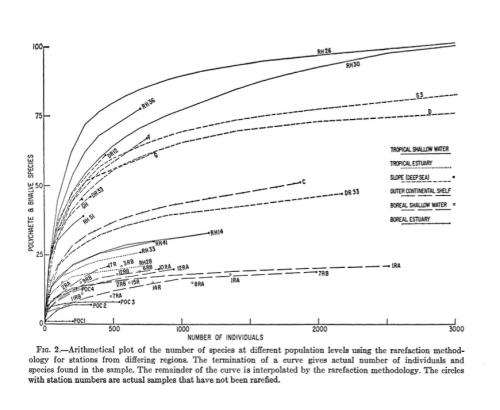To honor current and major advancements in research that either reveal key information, challenge our current notions, or generally bolster the field of deep-sea biology, the Deep-Sea Biology Society is pleased to announce an annual award for the Landmark Paper in Deep-Sea Biology Research. We are currently accepting nominations for papers published in 2015.
 History of deep-sea research:
History of deep-sea research:
Although various attempts at ocean exploration occurred throughout the world, exploration of the deep sea did not begin in earnest until the 19th century, with the voyage of the HMS Challenger generally considered to be the first scientific expedition to explore the deep sea. The papers and books published from this expedition are among the first scientific products related to deep-sea biological studies. Since this time, major advancements in technology have increased our ability to study the very deepest parts of the ocean. Our continued efforts regularly identify new species, communities, and reveal the processes that generate and maintain this diversity. We have advanced from believing the deep sea was void of life to Hessler and Sanders’ (1967) landmark study that revealed the deep benthos to be home to an astonishing diversity and abundance of life. This paper has become one of the most-cited papers in the field of deep-sea biology. Other key, highly-cited papers and advances in deep-sea research include but are not limited to Dayton and Hessler (1972), Corliss et al., (1979), Smith and Hessler (1987), Levin et al. (1991), Etter and Grassle (1992), Grassle and Maciolek (1992), Rex et al. (1993), Sibuet and Olu (1998), Sogin et al (2006). In this spirit of these influential papers and the contributions their authors made, the Deep-Sea Biology Society seeks to acknowledge a major advancement in deep-sea research by members of the Deep-Sea Biology Society in the previous year.
Award:
- 500 Pounds
- A featured write up on the Deep-Sea Biology Society Website.
Eligibility criteria:
- First author must be a current member of the Deep-sea Biology Society as of 15 May 2016 (application deadline). Open to all members, at any career stage, of the Deep-sea Biology Society. A paper can be nominated by anyone and not only the first author.
- The primary focus of the study must be related to the biology of the deep sea (below 200 m) as determined by the evaluation committee.
- Publication (in-print/citation) date must be between 1 January and 31 December 2015.
- Paper must add make a significant contribution to deep-sea biological science by revealing a new process or pattern, overturning current paradigms, or sparking new dialogue.
- Current board members and officers will not be eligible nor will any papers on which they are co-authors be eligible.
Application requirements:
- PDF of paper.
- Letter (paragraph up to one page) explaining why this paper is a landmark paper in deep-sea research (self-nominations will be accepted).
Evaluation process:
- Three board members and two members of the Deep-Sea Biology Society will evaluate the applications and papers and suggest finalists to the Society officers.
- Officers will vote and determine final winner.
- Winner to be announced in July 2016.
Submission details:
- Application deadline 15 May 2016 GMT.
- Submit applications to erineeaston@gmail.com with the subject “2015 DSBS Landmark paper – Last name of first author”
Literature cited:
Corliss, J.B., Dymond, J., Gordon, L.I., Edmond, J.M., 1979. Submarine thermal springs on the Galapagos Rift. Science 203, 1073-1082.
Dayton, P.K., Hessler, R.R., 1972. Role of biological disturbance in maintaining diversity in the deep sea. Deep-Sea Research 19, 199-208.
Etter, R.J., Grassle, J.F., 1992. Patterns of species diversity in the deep sea as a function of sediment particle-size diversity. Nature 360, 576-578.
Grassle, J.F., Maciolek, N.J., 1992. Deep-sea species richness: regional and local diversity estimates from quantitative bottom samples. American Naturalist 139, 313-341.
Hessler, R.R., Sanders, H.L., 1967. Faunal diversity in the deep-sea Deep Sea Research and Oceanographic Abstracts. Elsevier, pp. 65 IN25, 71-70 IN28-78.
Levin, L.A., Huggett, C.L., Wishner, K.F., 1991. Control of deep-sea benthic community structure by oxygen and organic-matter gradients in the eastern Pacific Ocean. Journal of Marine Research 49, 763-800.
Rex, M.A., Stuart, C.T., Hessler, R.R., Allen, J.A., Sanders, H.L., Wilson, G.D., 1993. Global-scale latitudinal patterns of species diversity in the deep-sea benthos. Nature 365, 636-639.
Sibuet, M., Olu, K., 1998. Biogeography, biodiversity and fluid dependence of deep-sea cold-seep communities at active and passive margins. Deep Sea Research Part II: Topical Studies in Oceanography 45, 517-567.
Smith, C.R., Hessler, R.R., 1987. Colonization and succession in deep-sea ecosystems. Trends in Ecology & Evolution 2, 359-363.
Sogin, M.L., Morrison, H.G., Huber, J.A., Welch, D.M., Huse, S.M., Neal, P.R., Arrieta, J.M., Herndl, G.J., 2006. Microbial diversity in the deep sea and the underexplored “rare biosphere”. Proceedings of the National Academy of Sciences 103, 12115-12120.

